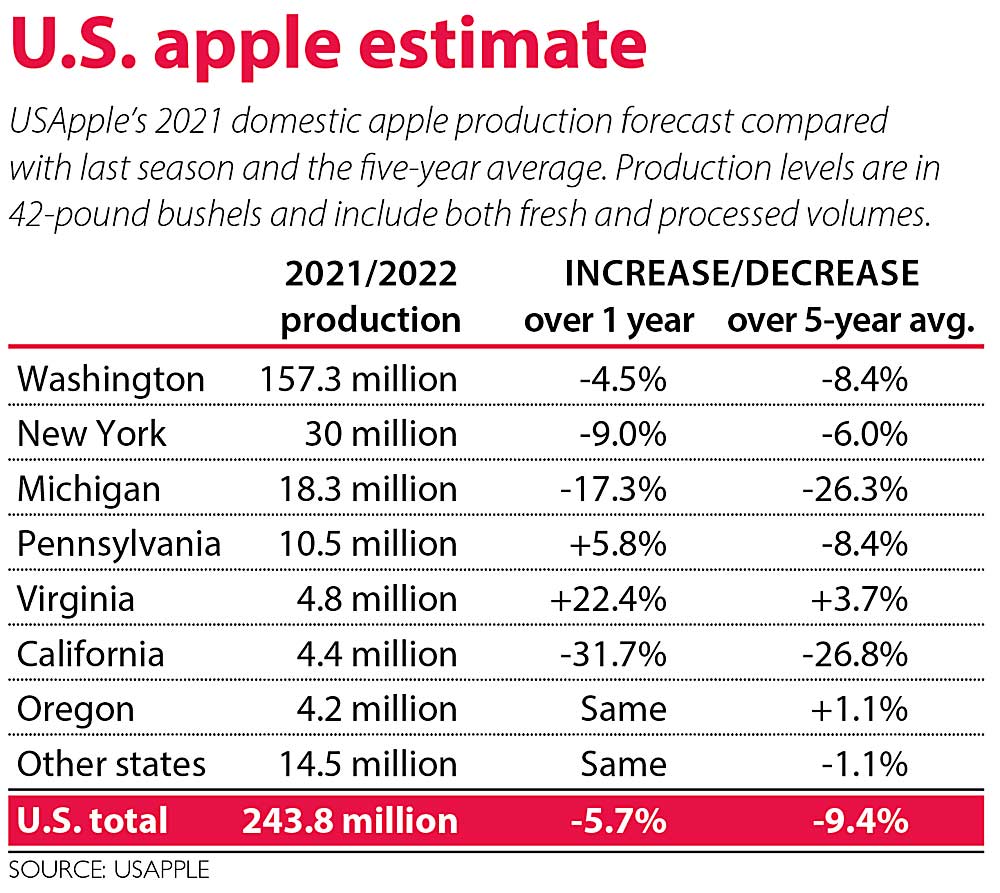
On Aug. 20, the U.S. Apple Association forecast the size of the 2021 U.S. apple crop: 243.8 million (42-pound) bushels.
The estimate was made during USApple’s Outlook Conference in Chicago, where leaders from growing regions around the country pinned down the final numbers. The 2021 estimate is down 6 percent from the 2020 crop and down 9 percent from the five-year average.
The USApple estimate is also 8 percent lower than the U.S. Department of Agriculture’s Aug. 12 estimate of 265.4 million bushels. Most of the difference between the estimates comes from Washington state, where industry leaders lowered USDA’s 176-million-bushel estimate to 157 million bushels, anticipating heat damage and harvest constraints from Pacific Northwest wildfires.
USApple’s Washington estimate of 157 million bushels is down 5 percent from its 2020 crop and down 8 percent from the five-year average. New York, the second largest apple state, expects to produce about 30 million bushels in 2021, down 9 percent from 2020 and down 6 percent from the five-year average. An April freeze will shrink Michigan’s 2021 crop down to an estimated 18.3 million bushels, down 17 percent from last year and down 26 percent from the five-year average.
Pennsylvania will produce 10.5 million bushels, up 6 percent from last year but down 8 percent from the five-year average. Rounding out the top seven states will be Virginia (4.8 million bushels), California (4.4 million) and Oregon (4.1 million). The remaining apple states will produce 14.4 million bushels, according to USApple.
Gala is expected to remain the top U.S. variety, with almost 49.3 million bushels, followed by Red Delicious (35.7 million). Honeycrisp (31 million) is estimated to be the third biggest variety for 2021, overtaking Fuji (29.1 million) and Granny Smith (27.2 million) for the first time.
China, the top global producer of apples, will produce about 2.3 billion bushels of apples in 2021. European countries will produce about 616 million bushels, while South America (mostly Argentina, Chile and Brazil) will produce 160 million bushels. Mexico will produce 25 million bushels, while Canada will produce 18.8 million bushels, according to USApple.
Chris Gerlach, USApple’s director of industry analytics, noted the U.S. apple industry’s growing efficiency. From 2007 to 2020, production increased by 13 percent, even though the number of bearing acres fell by 16 percent. Yields rose from about 620 bushels per bearing acre to about 825 bushels per bearing acre in that timeframe.
Gerlach shared other facts about the industry:
—The price U.S. growers receive for their apples has declined slightly. From 2011–2015, the five-year average farm-gate price for all apples was 31 cents per pound, while the price dropped to 30 cents per pound during the next five years.
—Domestic agricultural labor is becoming harder to find. From 2014 to 2020, average annual crop production employment fell by 3 percent. In apple orchards, the decline was 20 percent. The ag sector is losing domestic workers faster than it can replace them and is turning more often to the H-2A guest worker program. H-2A positions grew from 77,100 in 2011 to more than 275,000 in 2020, a 257 percent increase.
—by Matt Milkovich







Leave A Comment